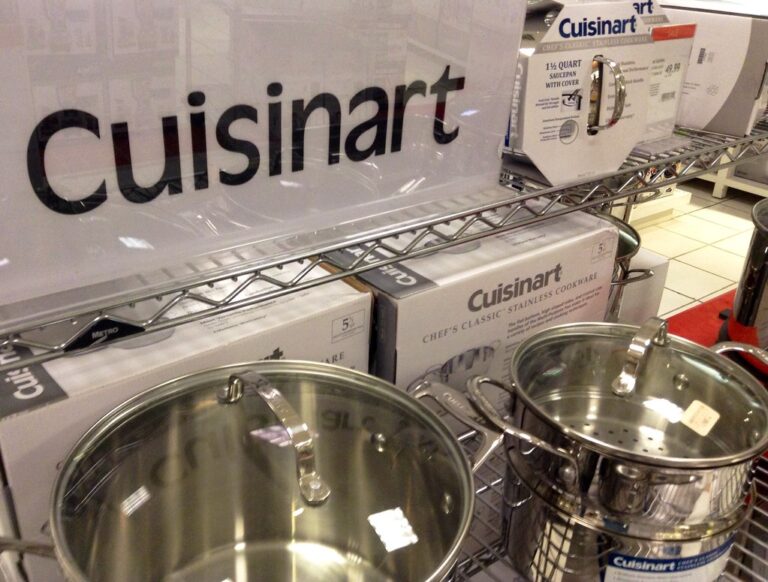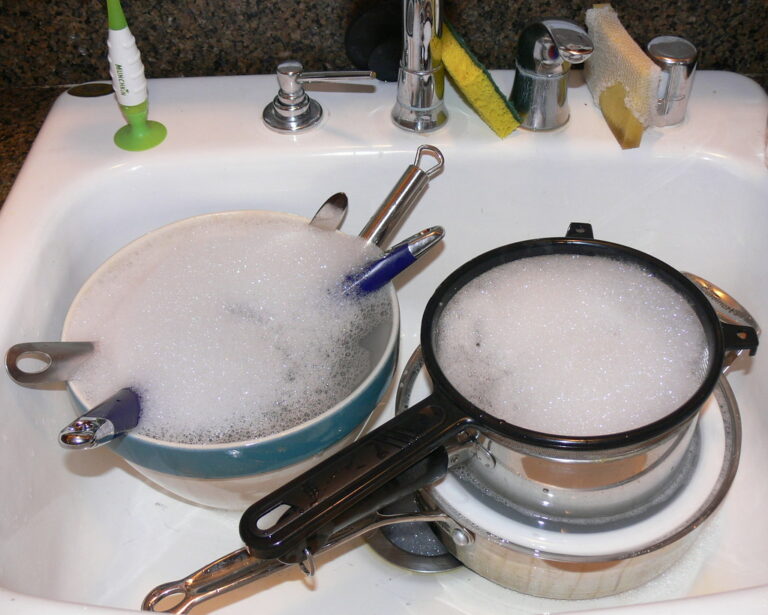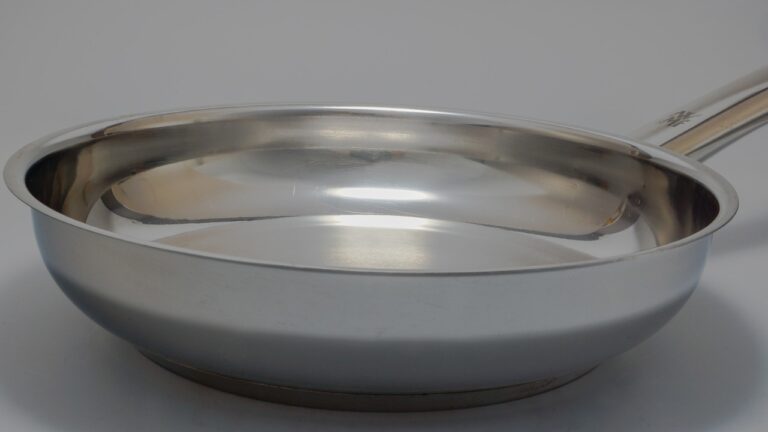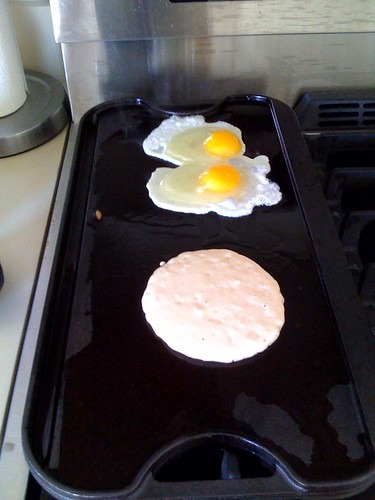I’ve always wondered why my food turns black when I cook it in a cast iron pan. It’s frustrating and makes me question my cooking skills. But after doing some research, I’ve discovered the science behind this phenomenon.
In this article, I’ll explain why a cast iron pan turns food black and how to prevent it from happening. So if you’re tired of dealing with burnt-looking meals, keep reading for some valuable insights and tips to improve your cooking experience with cast iron pans.
Key Takeaways
- Food turns black in a cast iron pan due to an oxidation process and chemical reactions.
- Proper seasoning of a cast iron pan is essential to prevent food from turning black.
- High heat oxidation, the Maillard reaction, and carbonization are factors that contribute to blackening in a cast iron pan.
- High heat and acidic ingredients can also lead to blackening, but proper preheating and temperature control can help prevent excessive blackening.
Understanding the Science Behind the Blackening Process
When you cook with a cast iron pan, it’s important to understand why the food turns black.
The blackening process occurs due to an oxidation process and chemical reactions that take place between the iron in the pan and the food being cooked.
When exposed to heat, moisture, and oxygen, a thin layer of iron oxide forms on the surface of the pan. This is commonly known as rust.
As you cook with the pan, this rust can come into contact with your food and cause it to turn black.
The high heat speeds up these chemical reactions, causing more rapid blackening of the food.
Understanding this science behind the blackening process helps us appreciate how cast iron pans work and allows us to take proper care of them for optimal cooking results.
Factors That Contribute to Food Turning Black in a Cast Iron Pan
One of the factors that can cause food to become black in a cast iron pan is excessive heat. When cooking with a cast iron pan, it’s important to remember that it retains heat very well, so using high heat can easily lead to overcooking and blackening of the food.
Another factor that contributes to the blackening process is the seasoning process of the cast iron pan. Seasoning involves coating the pan with a layer of oil and then heating it to high temperatures. This creates a non-stick surface and helps prevent rusting. However, if the seasoning is not properly done or maintained, it can result in burnt residue on the surface of the pan, which can transfer onto food during cooking and cause it to turn black.
Therefore, controlling heat and maintaining proper seasoning are key in preventing food from turning black in a cast iron pan.
Seasoning: the Key to Preventing Food From Turning Black
Properly seasoning a cast iron pan is essential for preventing food from becoming black. Without the protective layer of seasoning, the cast iron surface can react with the food, leading to undesirable outcomes like blackened food or even rust. So, what exactly happens when a cast iron pan turns food black? It all comes down to two chemical processes: the Maillard reaction and carbonization.
The Maillard reaction occurs when proteins and sugars in food undergo a complex series of chemical reactions upon exposure to heat. This reaction is responsible for browning and creating delicious flavors in cooked foods. However, without proper seasoning, the Maillard reaction can go awry in a cast iron pan, resulting in excessive browning that leads to blackened food.
On the other hand, carbonization is the breakdown of organic matter into charcoal-like substances due to high heat exposure. When cooking in an unseasoned or poorly seasoned cast iron pan, this carbonization process can occur more rapidly and intensely, causing food particles to stick and burn onto the surface.
To illustrate this concept further:
| Process | Cast Iron Pan Without Proper Seasoning | Cast Iron Pan With Proper Seasoning |
|---|---|---|
| Maillard Reaction | Excessive browning leading to blackened food | Desired browning and enhanced flavors |
| Carbonization | Rapid breakdown of organic matter resulting in burnt residue | Reduced sticking and burning of food particles |
How High Heat Causes Food to Blacken in a Cast Iron Pan
When it comes to cooking in a cast iron pan, understanding the science behind why food turns black is essential.
High heat oxidation occurs when the fats and oils in the food react with oxygen, leading to discoloration.
Additionally, the Maillard reaction plays a significant role as it produces browning and flavor compounds when proteins and sugars are heated together.
Lastly, the carbonization process breaks down complex molecules into simpler ones, resulting in a blackened appearance on the surface of the food.
High Heat Oxidation
The main reason a cast iron pan turns food black is because it undergoes high heat oxidation. When I cook with my cast iron pan, the intense heat causes a chemical reaction between the iron in the pan and the oxygen in the air. This oxidation process creates a layer of blackened material on the surface of the pan.
As I continue to cook, this black layer can transfer onto my food, giving it that distinct black color. It’s important to note that this is a natural occurrence and doesn’t affect the taste or safety of the food.
To prevent excessive blackening, I make sure to properly season my cast iron pan before each use and avoid cooking highly acidic foods for long periods of time.
Overall, understanding the oxidation process and heat transfer helps me better care for my cast iron pan and enjoy delicious meals cooked with it.
Maillard Reaction Explanation
To understand why your food develops a rich flavor and browned crust, let’s delve into the explanation of the Maillard reaction. The Maillard reaction is a chemical reaction that occurs when amino acids and reducing sugars are exposed to heat. It is responsible for the deep flavors and attractive browning that we associate with cooked food. This reaction involves a complex series of reactions between amino acids and sugars, resulting in the formation of new compounds that contribute to flavor, aroma, and color. Heat plays a crucial role in this process as it provides the energy necessary for these reactions to occur. The higher the temperature, the faster the Maillard reaction takes place, leading to more intense flavors and darker browning.
Table:
| Principle | Description | Example |
|---|---|---|
| Temperature | Higher temperatures accelerate the Maillard reaction | Grilling steak at high heat |
| Amino Acids | Reaction involves amino acids from proteins | Browning of bread crusts |
| Reducing Sugars | Reaction requires sugars with reactive carbonyl groups | Caramelization of sugar |
Carbonization Process Breakdown
You can achieve a carbonized texture on your dish by exposing it to high heat for an extended period of time. Carbonization is the process in which organic matter, like food, undergoes thermal decomposition and turns into carbon.
When cooking with a cast iron pan, this process can occur if the heat is too high or if the food is left on the pan for too long. However, there are ways to prevent blackening and maintain the desired flavor and appearance of your dish.
One way is to control the heat by using medium or low settings instead of high heat. Additionally, regularly stirring or flipping the food can help distribute the heat evenly and prevent excessive charring.
The Role of Oil and Fat in Blackening Food in a Cast Iron Pan
When it comes to blackening food in a cast iron pan, understanding the role of oil and fat is crucial. The browning reaction process that occurs with oil plays a significant part in creating that desirable crust on our food.
Additionally, high heat has a profound impact on this process, as it accelerates the Maillard reaction, resulting in deeper flavors and enhanced texture.
Oil’s Browning Reaction Process
If you heat oil in a cast iron pan, it creates a browning reaction process that turns your food black.
The browning process explanation is quite fascinating. When the oil reaches its smoke point and heats up, it undergoes chemical changes, which results in the Maillard reaction.
This reaction occurs between the proteins and sugars present in the food. As heat is applied to the oil, it breaks down these compounds and forms new flavors, aromas, and colors.
The high temperatures of a cast iron pan facilitate this process by providing an ideal environment for the Maillard reaction to take place.
Impact of High Heat
Using high heat while cooking with oil in a cast iron pan can result in a beautiful caramelization of your food. However, it’s important to consider both food safety and the impact of blackened food on taste and presentation.
When cooking at high heat, you need to be mindful of proper food handling practices to prevent any potential health risks. It is crucial to ensure that the internal temperature of the cooked food reaches a safe level to kill any harmful bacteria.
Additionally, while blackened food may add an appealing charred flavor, it can also affect the overall taste and appearance of your dish. Some people enjoy the smoky taste and rustic appearance, while others prefer their food to have a lighter color and milder flavor.
Ultimately, it’s a matter of personal preference and understanding how high heat can influence both food safety and culinary aesthetics.
Acidic Ingredients and Their Effect on Food in a Cast Iron Pan
Acidic ingredients can cause food to turn black in a cast iron pan. It’s happened to me more times than I can count. The blackening process can be frustrating, especially when you’re trying to cook a delicious meal.
Here are a few things that I’ve learned along the way:
- Lemon juice: This tangy ingredient can quickly turn your food black if left in contact with the pan for too long. It’s important to add it at the end of cooking or use it sparingly.
- Tomatoes: The acidity in tomatoes is notorious for causing discoloration in cast iron pans. To minimize blackening, try using canned tomatoes instead of fresh ones.
- Vinegar: Whether it’s apple cider vinegar or balsamic vinegar, both have enough acidity to darken your food. Be cautious and add them carefully.
- Wine: While wine adds amazing flavor to dishes, it also has acidic properties that can lead to blackened food in a cast iron pan.
Remember these tips and adjust your cooking methods accordingly to prevent your food from turning into an unsightly shade of black.
The Importance of Proper Preheating to Avoid Blackened Food
I’ve learned that preheating is crucial to prevent blackening of food in a cast iron pan. By preheating the pan before adding any ingredients, it allows for even heat distribution and helps create a non-stick surface.
Temperature control is also essential in achieving successful cooking results, as too high of a temperature can lead to burning or blackening of the food. So, ensuring proper preheating and maintaining the right temperature throughout the cooking process are key factors in avoiding blackened food when using a cast iron pan.
Preheating Prevents Blackening
To prevent blackening, make sure you preheat the cast iron pan before cooking. This step is crucial in ensuring that your food cooks evenly and doesn’t stick to the surface. When you preheat your cast iron pan, you are allowing it to reach the desired temperature, which helps create a natural non-stick surface.
Here are some benefits of using a cast iron pan and alternative cooking techniques:
- Superior heat retention: A cast iron pan holds heat exceptionally well, allowing for even cooking throughout your dish.
- Versatility: You can use a cast iron pan on various heat sources such as stovetops, ovens, or even over an open fire.
- Durability: Cast iron pans are built to last and can withstand high temperatures without warping or scratching.
- Health benefits: Cooking with a cast iron pan can help increase your dietary intake of essential minerals like iron.
Temperature Control Is Crucial
Maintaining proper temperature control is crucial for achieving the desired cooking results in your cast iron. When it comes to cooking with cast iron, the right temperature can make all the difference between a perfectly cooked meal and burnt spots on your food. Controlling the heat allows you to cook your dishes evenly and avoid those unsightly blackened areas.
One important factor to consider is the impact of cooking time on temperature control. Different foods require different cooking times, and adjusting the heat accordingly is essential. For example, if you’re searing a steak, you’ll want to start with high heat to get that nice crust but then lower it to medium-low to ensure even cooking without burning.
To illustrate this further, take a look at this table:
| Food | Recommended Cooking Temperature |
|---|---|
| Steak | High (450°F – 500°F) |
| Pancakes | Medium (350°F – 375°F) |
| Eggs | Low (250°F – 300°F) |
How to Clean and Maintain a Cast Iron Pan to Prevent Blackening
Cleaning and maintaining a cast iron pan regularly is essential for preventing blackening. As someone who loves cooking with cast iron, I’ve learned a few cleaning techniques and maintenance practices that help keep my pan in top shape.
Here are some tips to ensure your cast iron pan stays in pristine condition:
- Seasoning: Regularly season your cast iron pan with oil to create a protective layer that prevents food from sticking.
- Gentle scrubbing: Avoid using harsh chemicals or abrasive materials when cleaning your pan. Instead, opt for gentle scrubbing with warm water and a soft brush.
- Drying thoroughly: After washing, make sure to dry the pan completely to prevent rust formation.
- Storing properly: Store your cast iron pan in a dry place after it’s fully dried to maintain its quality.
Common Mistakes That Lead to Food Turning Black in a Cast Iron Pan
One of the most common mistakes I make when using a cast iron pan is not properly preheating it before adding food. This can lead to uneven heating and a higher chance of food sticking to the pan. To avoid this, it’s important to preheat the cast iron pan on medium to high heat for a few minutes before adding any ingredients.
In addition, there are some other common mistakes that can result in food turning black in a cast iron pan. One mistake is using high heat alternatives such as nonstick cooking sprays or vegetable oils with low smoke points. These can burn easily and cause your food to turn black.
Another mistake is not properly seasoning your cast iron pan. Seasoning helps create a natural non-stick surface and prevents food from sticking and turning black. It’s important to follow the manufacturer’s instructions for seasoning your cast iron pan properly.
To summarize, proper preheating, avoiding high heat alternatives, and ensuring proper seasoning are key steps in preventing your food from turning black in a cast iron pan.
| Common Mistakes | Solutions |
|---|---|
| Not preheating | Preheat the pan |
| Using high heat alternatives | Opt for oils with higher smoke points |
| Improper seasoning | Follow manufacturer’s instructions |
Tips and Tricks for Cooking in a Cast Iron Pan to Avoid Blackening
When cooking in a cast iron pan, it’s important to adjust the heat as needed to prevent burning. Here are some tips and tricks for cooking in a cast iron pan to avoid blackening:
- Use low to medium heat: This helps distribute the heat evenly and prevents hot spots that can lead to burning.
- Preheat the pan: This ensures that the food cooks evenly and reduces the chances of sticking or burning.
- Avoid overcrowding: Give your food enough space in the pan so that it can cook properly without releasing excess moisture.
- Consider alternative cooking methods: Try baking, grilling, or broiling your food instead of frying it in a cast iron pan. These methods allow for more controlled cooking and reduce the risk of blackened food.
Exploring Alternative Cooking Methods to Prevent Blackened Food
If you’re looking to prevent blackened food, it’s worth considering alternative cooking methods such as baking, grilling, or broiling. These alternative cooking techniques can help you achieve delicious and flavorful dishes without the risk of blackening your food.
Baking is a great option for foods that require gentle heat and even cooking, like casseroles or desserts. Grilling is perfect for meats and vegetables, giving them a smoky flavor and charred exterior without turning them black. Broiling is another fantastic method that uses intense heat from above to quickly cook and brown your food.
Troubleshooting Guide: How to Fix Blackened Food in a Cast Iron Pan
Using the wrong heat setting on a gas stove can cause your dishes to become blackened in a cast iron pan. It’s frustrating when you spend time preparing a meal, only to have it ruined by burnt residue. Luckily, there are troubleshooting tips that can help you fix this common mistake and save your dish.
Here are some handy tips to troubleshoot blackened food in a cast iron pan:
- Adjust the heat: Ensure that you’re using the right heat setting for your gas stove.
- Preheat properly: Allow your cast iron pan to fully preheat before adding any ingredients.
- Control oil temperature: Make sure the oil is hot enough but not smoking before adding food.
- Proper cleaning and seasoning: Regularly clean and season your cast iron pan to maintain its non-stick properties.
Conclusion
In conclusion, understanding the science behind why a cast iron pan turns food black is essential for preventing this issue.
Factors such as seasoning, high heat, and the role of oil and fat all play a role in blackening food.
By avoiding common mistakes and following tips and tricks for cooking in a cast iron pan, you can successfully prevent your food from turning black.
However, if you do encounter blackened food, our troubleshooting guide provides helpful solutions to fix the problem.




